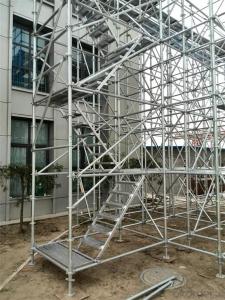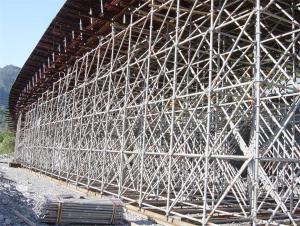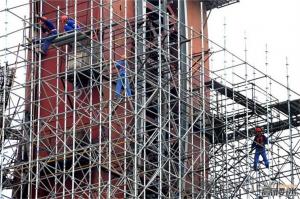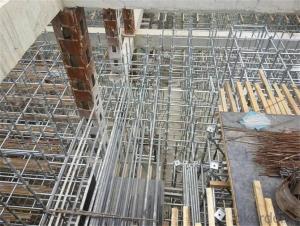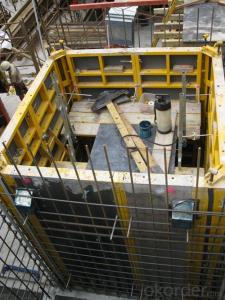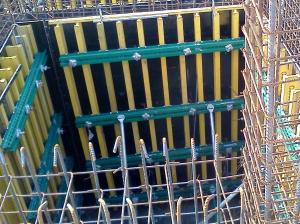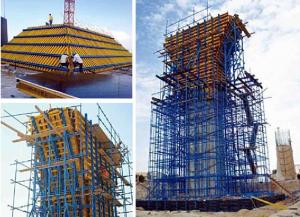RingLock Scaffolding with Cold Galvanized Surface Processing
- Loading Port:
- Shanghai
- Payment Terms:
- TT OR LC
- Min Order Qty:
- 1000 m²
- Supply Capability:
- 100000 m²/month
OKorder Service Pledge
OKorder Financial Service
You Might Also Like
1.Structure of Ring lock Description
Ringlock Scaffolding system is the most popular used Scaffolding system in the world.It will greatly reduce the cost because of the following advantages
Packaging & Delivery
Packaging Details:
Pallet or bag or upon client's request
Delivery Detail:
35days
2.Main Features of Ringlock
It will greatly reduce the cost because of the following advantages
1)Using less pipes
2)Easy to install
3)It can be used again and again for nearly 20years
3.Ring lock product pictures:
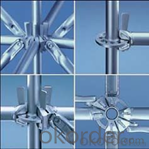
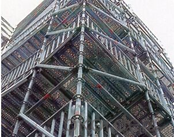
4.Ringlock Product Description
Type: ringlock scaffolding diagonal Brace
specification : Ø48.3×3.20
material:: steel Q235
Finished: Hot DIP galvanized, painted
Diagonal length(m) :Weight(kg)
0.9m * 1.25m 6.28
1.25m * 2.7m 11.45
5.FAQ
We have organized several common questions for our clients,may help you sincerely:
1)How about your company?
CNBM International Corporation, China National Building Materials (Group) Corporation, is one of the largest companies in China building material equipment industry, Our formwork and scaffolding are largely used in both domestic and all over world;
2)How many Scaffolding your company have?
Here comes our 5 types of Scaffolding systems:
- Cup lock Scaffolding(C-Lock Scaffolding)
- Ring lock Scaffolding
-Kwistage Scaffolding
-H-frame Scaffolding
-ID15 Scaffolding Tower, this type Scaffolding is the most widely used in construction, such like bridge.
3)How long can we receive the product after purchase?
Lead time is about 30days after getting the signed PI and deposit.
- Q:Can steel frame formwork be used for circular or cylindrical structures?
- Yes, steel frame formwork can be used for circular or cylindrical structures. Steel frame formwork is a versatile and flexible system that can be easily adjusted to form various shapes and sizes, including circular or cylindrical structures. The steel frames are designed to be adjustable and can be curved or bent to match the desired shape of the structure. Additionally, the formwork panels can be attached to the steel frames to create a seamless and continuous mold for pouring concrete. This allows for the construction of circular or cylindrical structures with precise dimensions and smooth finishes. Overall, steel frame formwork is a suitable choice for forming circular or cylindrical structures due to its adaptability and ability to create complex shapes.
- Q:What are the common quality control measures for steel frame formwork systems?
- Some common quality control measures for steel frame formwork systems include regular inspection and maintenance of the formwork components, ensuring proper alignment and stability of the frames, conducting load testing to verify their strength and durability, monitoring the formwork installation process to ensure proper assembly and connection of the frames, and conducting regular checks on the concrete finish and dimensions achieved using the formwork system.
- Q:Is steel frame formwork suitable for all types of construction projects?
- No, steel frame formwork is not suitable for all types of construction projects. While it offers several advantages such as high durability, strength, and reusability, it may not be the most appropriate choice for certain projects. Steel frame formwork is commonly used for large-scale construction projects such as high-rise buildings, bridges, and heavy industrial structures where the need for strength and stability is paramount. However, for smaller projects or projects with intricate designs, traditional formwork systems such as timber or aluminum may be more suitable due to their flexibility and ease of customization. Additionally, the cost of steel frame formwork can be higher compared to other formwork systems, which may not be feasible for projects with tight budgets. Therefore, the suitability of steel frame formwork depends on the specific requirements, scale, and complexity of the construction project.
- Q:Does steel frame formwork require any specialized equipment for installation?
- The installation of steel frame formwork necessitates the use of specialized equipment. This is due to the fact that steel frame formwork is comprised of steel frames, panels, and accessories, all of which are employed to construct temporary molds for concrete structures. The installation procedure entails the assembly of the steel frames and panels, ensuring their alignment and secure connection. In order to facilitate this installation process, specialized equipment such as cranes, forklifts, or hoists may be necessary to lift and position the weighty steel frames and panels into their designated locations. Furthermore, specialized tools like spanners, wrenches, and clamps are required to securely fasten the frames and panels together. Furthermore, steel frame formwork systems often encompass adjustable components that accommodate various concrete structures. In order to attain proper alignment and leveling of the formwork, the necessary adjustments may involve specialized equipment such as hydraulic jacks, screws, or wedges. On the whole, the utilization of specialized equipment during the installation of steel frame formwork is imperative to guarantee the accurate and safe assembly of the formwork system, thereby permitting the construction of top-notch concrete structures.
- Q:Can steel frame formwork be used for both monolithic and modular slab construction?
- Yes, steel frame formwork can be used for both monolithic and modular slab construction. Steel frame formwork is a versatile and durable system that can be easily adapted to different construction methods and requirements. In monolithic slab construction, steel frame formwork provides a stable and strong support structure for pouring concrete. The steel frames can be easily assembled and adjusted to form the desired shape and dimensions of the slab. The formwork is designed to withstand the pressure and weight of the concrete, ensuring a smooth and even finish. In modular slab construction, steel frame formwork can also be used effectively. The modular approach involves pre-fabricating individual slab sections off-site and then assembling them at the construction site. Steel frame formwork allows for precise and accurate assembly of the modular slabs, ensuring a high level of quality and consistency. The strength and stability of the steel frames ensure that the modular slabs can be safely transported and installed without any issues. Overall, steel frame formwork is a versatile solution that can be used for both monolithic and modular slab construction. Its strength, durability, and adaptability make it an ideal choice for various construction projects.
- Q:What types of concrete structures can be built using steel frame formwork?
- Steel frame formwork can be used to build a wide range of concrete structures. Some common examples include: 1. High-rise buildings: Steel frame formwork is often used in the construction of tall buildings because it provides strength and stability. It can be easily assembled and disassembled, making it suitable for multiple floors. 2. Bridges and flyovers: Steel frame formwork is well-suited for constructing bridges and flyovers due to its ability to support heavy loads. It can be customized to match the specific shape and size required for the structure. 3. Industrial structures: Steel frame formwork is commonly used in the construction of industrial buildings such as factories, warehouses, and power plants. Its versatility allows for the creation of large, open spaces that can accommodate machinery and equipment. 4. Residential buildings: Steel frame formwork can be used to construct residential buildings of various sizes and designs. It provides flexibility in terms of layout and can withstand the weight of multiple floors. 5. Commercial complexes: Steel frame formwork is an ideal choice for constructing commercial complexes, such as shopping malls, office buildings, and hotels. It can accommodate different architectural styles and allows for the integration of various amenities. 6. Stadiums and sports facilities: Steel frame formwork is often used in the construction of sports facilities due to its ability to create large, open spaces. It can support the weight of spectator seating and provide the necessary structural integrity. Overall, steel frame formwork is a versatile construction technique that can be used to build a wide variety of concrete structures, ranging from high-rise buildings to bridges and industrial facilities. Its strength, stability, and flexibility make it a popular choice in the construction industry.
- Q:Are there any limitations or disadvantages to using steel frame formwork?
- Using steel frame formwork does have limitations and disadvantages. One limitation is the higher initial cost compared to other types of formwork like timber formwork. Steel is more expensive to purchase and requires specialized tools and equipment for installation and removal, making it less cost-effective for small-scale projects or those with tight budgets. Another disadvantage is the weight of steel frame formwork. Steel is a heavy material, making it difficult to handle and transport. This can slow down construction and require additional labor and equipment for movement. Additionally, skilled labor is needed for the installation and removal of steel formwork. It is a complex and time-consuming process that requires workers with specialized training and experience. This can increase labor costs and potentially cause delays. Moreover, steel formwork lacks flexibility compared to other types. Once the steel frame is fabricated, it cannot be easily modified or adjusted to accommodate design changes or variations in the construction process. This inflexibility can be a disadvantage if unforeseen changes arise during the project. Lastly, steel frame formwork may not be suitable for all construction projects. It is commonly used for large-scale projects where the benefits of steel, such as its strength and durability, outweigh the limitations and disadvantages. Smaller or simpler projects may find alternative formwork systems to be more cost-effective and efficient. In conclusion, while steel frame formwork has advantages in terms of strength and durability, it is important to consider its limitations and disadvantages when selecting the appropriate formwork system for a construction project.
- Q:Can steel frame formwork be used for the construction of swimming pools?
- Yes, steel frame formwork can be used for the construction of swimming pools. Steel frame formwork is a popular choice for constructing swimming pools due to its durability, strength, and ability to withstand the pressure of concrete pouring. It provides a strong and stable structure that can handle the weight of the concrete and water in the pool. Additionally, steel frame formwork can be easily customized and adjusted to create different pool shapes and sizes. It is also reusable, which makes it a cost-effective option for pool construction projects. Overall, steel frame formwork is a suitable choice for the construction of swimming pools.
- Q:What are the requirements for the installation and the characteristics of the chimney sliding formwork
- Economy: to ensure the quality of the project, safety and duration of the premise, as far as possible to reduce the one-time investment, increase the number of times the template turnover, reduce the use of labor, to achieve civilized construction.
- Q:Are there any limitations to the size or shape of structures that can be constructed using steel frame formwork?
- Yes, there are limitations to the size and shape of structures that can be constructed using steel frame formwork. While steel frame formwork is a versatile construction method, it does have certain constraints. One limitation is the size of the steel frames themselves. These frames come in standard sizes and dimensions, and the structure being constructed must conform to these dimensions. If a project requires unconventional or non-standard dimensions, additional customization or modifications may be necessary, which can increase costs and construction time. Another limitation is the weight-bearing capacity of the steel frame formwork. Steel frames have a maximum load capacity that must be respected to ensure structural integrity and safety. Depending on the design and purpose of the structure, the weight of the materials used, and the expected loads, the size and spacing of the steel frames may need to be adjusted accordingly. The shape of the structure is also a limiting factor. Steel frame formwork is typically well-suited for rectangular or square structures, as it can easily accommodate straight lines and right angles. However, if a project requires complex or irregular shapes, additional measures, such as custom-made formwork or additional support structures, may be necessary to achieve the desired design. In summary, while steel frame formwork offers many advantages in construction, there are limitations to the size and shape of structures that can be built using this method. These limitations stem from the standard sizes and load-bearing capacity of the steel frames, as well as the constraints of accommodating unconventional dimensions or complex shapes.
1. Manufacturer Overview |
|
|---|---|
| Location | |
| Year Established | |
| Annual Output Value | |
| Main Markets | |
| Company Certifications | |
2. Manufacturer Certificates |
|
|---|---|
| a) Certification Name | |
| Range | |
| Reference | |
| Validity Period | |
3. Manufacturer Capability |
|
|---|---|
| a)Trade Capacity | |
| Nearest Port | |
| Export Percentage | |
| No.of Employees in Trade Department | |
| Language Spoken: | |
| b)Factory Information | |
| Factory Size: | |
| No. of Production Lines | |
| Contract Manufacturing | |
| Product Price Range | |
Send your message to us
RingLock Scaffolding with Cold Galvanized Surface Processing
- Loading Port:
- Shanghai
- Payment Terms:
- TT OR LC
- Min Order Qty:
- 1000 m²
- Supply Capability:
- 100000 m²/month
OKorder Service Pledge
OKorder Financial Service
Similar products
New products
Hot products
